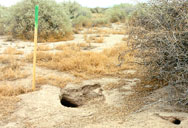

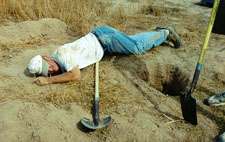
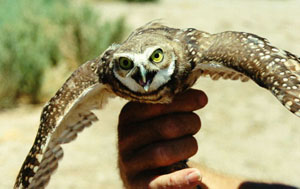
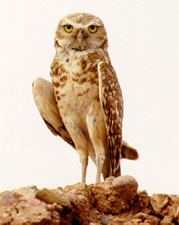
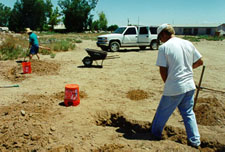

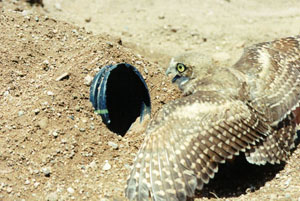
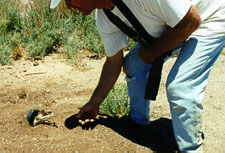
Burrowing Owl Artificial Nest Box Project
Natural Burrow Removal and Burrowing Owl Relocation
 |
This photo shows the opening to a natural burrow used by a family of Burrowing Owls. Sometimes a burrow has more than one opening as nearby smaller tunnels are enlarged and become incorporated into a bigger burrow. The wooden stake next to the burrow was placed there to help locate the burrow. Even though it was for only a short time, the owls really liked the new stakes, and usually there was an owl perched on a new stake all the time. |
 |
Here Bob Fox of Wild At Heart (Cave Creek, Arizona) inserts a video inspection camera into a burrow to check for the presence of owls as burrow excavation proceeds. Although the camera cable is very long, it is usually only possible to get the camera in about five feet before hitting a sharp turn in the tunnel. However, digging can proceed in that section with some certainty that there aren't any owls in that part of the burrow. Sometimes odd things are found in the tunnels this way. During one of the burrow inspections, a large toad was discovered that filled the tunnel so that the camera could not go past. In addition, the toad was not about to move, even when the camera plastic lens cover bonked him on the nose. One would think that a big snake-looking thing coming directly at you would be enough to scare a toad into high-speed flight. Apparently not, so the tunnel inspection had to be completed after the toad had left. |
 |
A burrow often has side tunnels, and these must be found. Here Bob Fox feels around the sides of the tunnel to try to find other tunnels where owls could be hiding. In the process of checking the burrows, a number of juvenile owls were discovered. The juveniles were removed, banded with U.S. Fish and Wildlife leg bands, and released in the same area at artificial nest sites. |
 |
Bob Fox is holding one of the Juvenile Burrowing Owls removed from a burrow. The facial pattern of a juvenile has more white than that of an adult (shown below). |
 |
Adult Burrowing Owl |
 |
Here Bob Fox and a homeowner near the new housing development begin the excavation for two new artificial burrows.This is the release site for the juvenile owls removed from natural burrows located only a few hundred feet away.Each site is chosen so that the burrow entrance is not located where water can pond and flood the burrows. |
 |
Here is one of the artificial burrows, complete with perch built by the homeowner. Burrowing Owls need a perch near the burrow so they have a good place to look out for predators. Now this burrow is all set for its new arrivals. |
 |
As soon as the juvenile Burrowing Owl sees the burrow opening she knows what to do. In a fraction of a second she enters the opening and disappears. |
 |
This shows how the release is done. Bob Fox has shown the juvenile Burrowing Owl the entrance to the burrow and then released the bird. In an instant the bird flies and runs into the tunnel. It happens so fast, it is difficult to photograph the bird as it moves through the entrance. |
Imagine taking a vacation and returning home to discover that a landslide has buried your house. This is what has been happening to Burrowing Owls for the past 150 years. Either because the holes are a nuisance or because the land gets covered with houses, the end result is always the same: the Burrowing Owl loses a home. Even if there is a plentiful food source, the loss of burrows in an area means that the owls can't live there, and so the bird's range shrinks a little more. Eventually, the far reaches of the range begin to show the effects. The Burrowing Owl is currently on the endangered species list in Canada. After breeding in Canada, an owl might return to his winter home in Arizona, only to find it covered over. Now this owl must find a new home to make it through the winter. If he is unable to find a new winter home, he probably won't survive to make the trip back to Canada. In this way, the Canadian owl population, located at least 1000 miles from Phoenix, suffers losses because of development pressure in Arizona. The goal of the artificial burrow project is to provide excess burrows to take the pressure off the owls for finding new homes. A long time ago, burrow sites were plentiful and the owls would never have a problem finding a new home. It is still possible to begin installing replacement burrows and reverse some of the damage.
Questions?, type in b i r d i n f o @ m i r r o r - p o l e . com into your email program to contact us.
Copyright Greg Clark, 2001